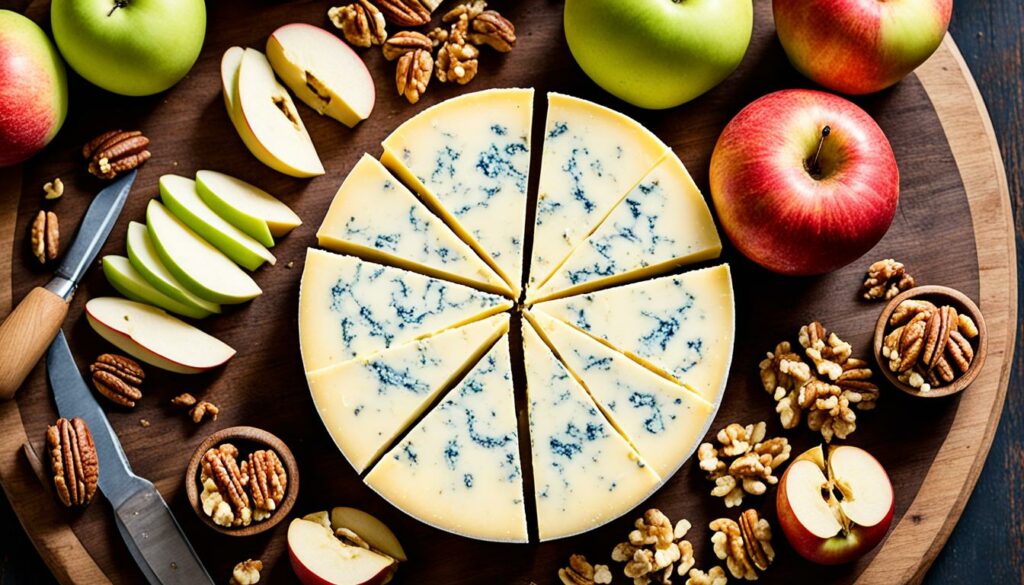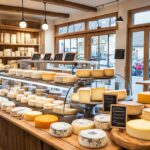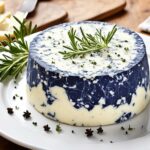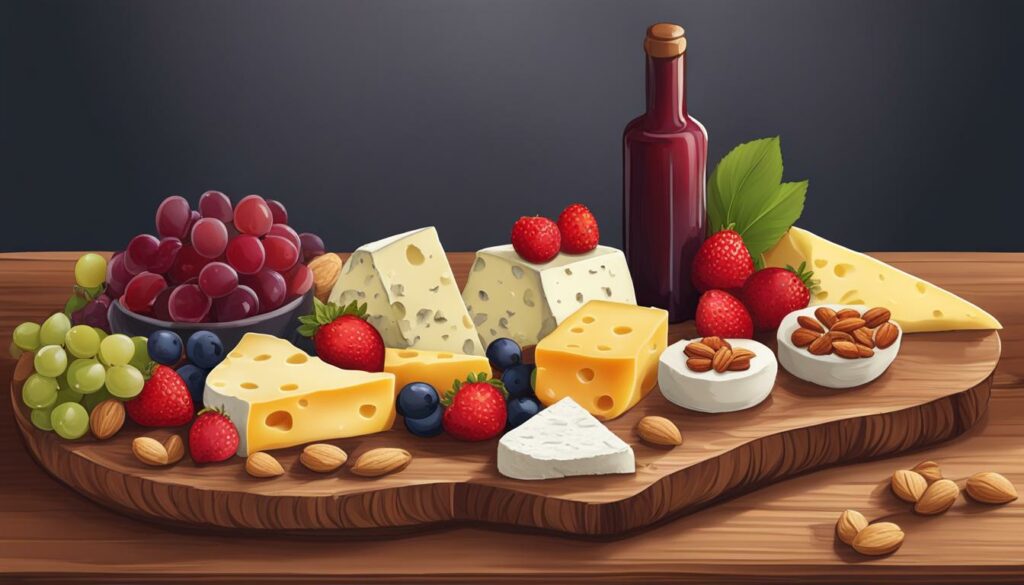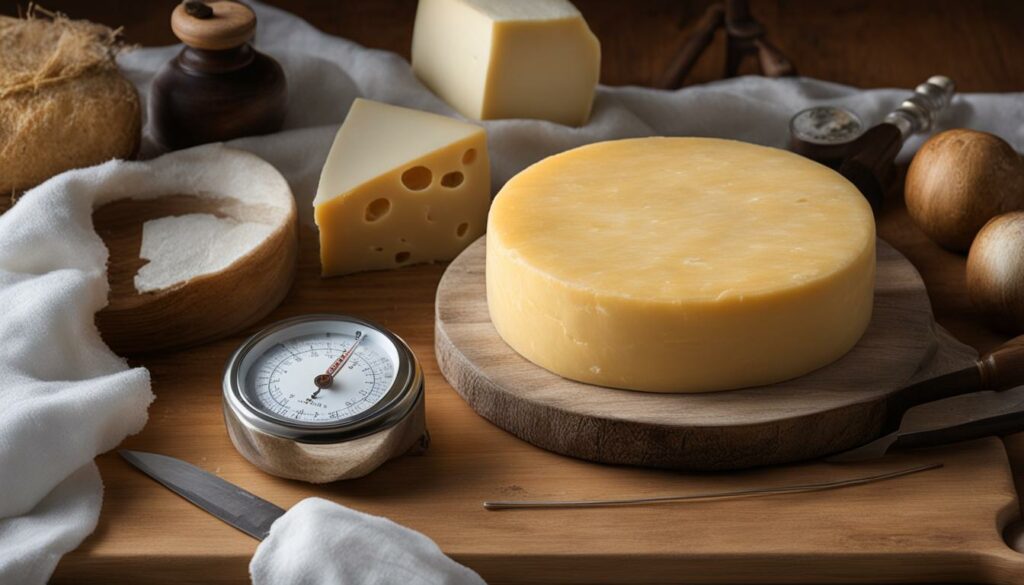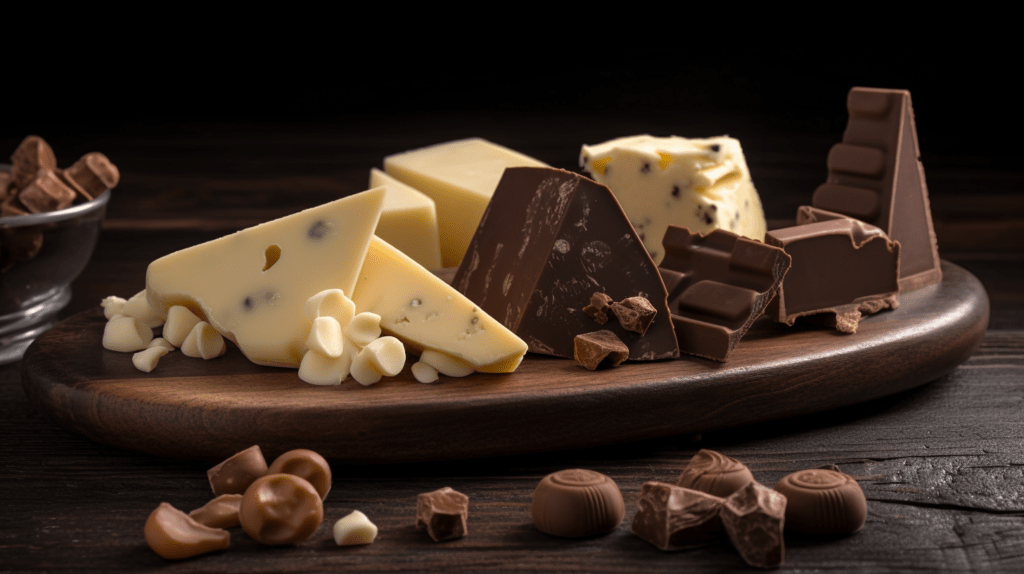Welcome to a culinary journey of flavors with Bleu Des Causses Cheese, an artisanal French blue cheese that embodies a tradition of cave-aged excellence.
Originating from the Languedoc region of southern France, this hidden gem offers a unique and delightful experience for cheese connoisseurs and food enthusiasts alike.
Bleu Des Causses Cheese – A Taste of France’s Languedoc Region
Indulge in the flavors of the Languedoc region in southern France with Bleu Des Causses Cheese. This AOC protected cheese is a true culinary gem, known for its rich taste and distinct character.
Comparable to the famous Roquefort cheese, Bleu Des Causses shares a similar production process. Crafted from raw unpasteurized cow’s milk, this cheese is handmade using traditional methods that have been passed down through generations.
The aging process takes place in natural caves in the Causses region, allowing the cheese to develop its unique flavor profile. The result is a semi-soft and crumbly texture, an ivory yellow color, and a creamy consistency that melts in your mouth.
With each bite, you’ll experience the essence of the Languedoc region, transported by the earthy and nuanced flavors of this exceptional cheese. Bleu Des Causses Cheese truly encapsulates the culinary traditions and terroir of southern France.
The Flavor and Pairings of Bleu Des Causses Cheese
Bleu Des Causses Cheese is renowned for its rich and buttery taste, with a distinct tanginess from the blue mold veins. The aging process in natural limestone caves gives it an earthy undertone and complexity. Some consumers also detect notes of mushrooms or grass in the finish.
Pairings
This cheese pairs well with a variety of flavors, making it a versatile choice for your culinary creations. Whether you’re enjoying it on its own or incorporating it into a recipe, there are endless possibilities for pairing Bleu Des Causses Cheese.
- For a wine pairing, try Cornas, Lirac, or Jurançon wines. The robust flavors of these wines complement the rich and tangy notes of the cheese.
- If you prefer savory dishes, consider adding Bleu Des Causses Cheese to omelets, pasta dishes, or roasted potatoes. The creamy texture and bold flavor will elevate your recipes to new heights.
- For a refreshing combination, pair this cheese with fresh fruits such as pears, grapes, or apples. The sweetness of the fruit beautifully balances the tanginess of the cheese.
Whether you’re hosting a dinner party or simply indulging in a cheese platter for one, Bleu Des Causses Cheese is sure to impress with its rich, buttery taste and tangy complexity. Explore different pairings and let your taste buds guide you on a delightful culinary journey.
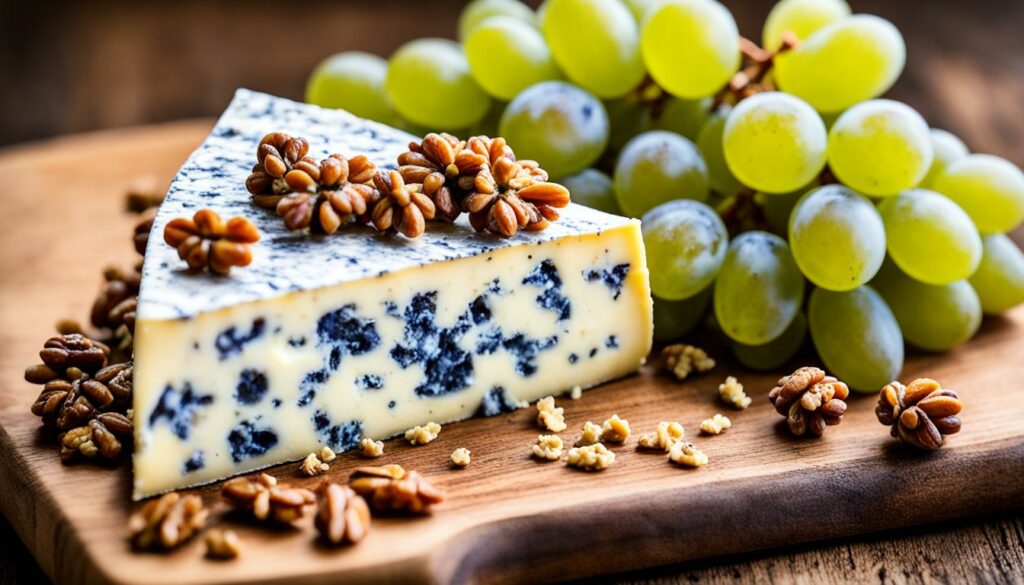
The History and Origin of Bleu Des Causses Cheese
Bleu Des Causses Cheese has a rich and fascinating history. Its origins can be traced back to the Aveyron region in France, where it was created in 1926. This artisanal French blue cheese carries with it a legacy that spans nearly a century, making it a true treasure of French culinary heritage.
The production of Bleu Des Causses Cheese begins with carefully selected full-fat cow’s milk sourced from local farms. The cheese is then crafted using traditional techniques passed down through generations of cheese artisans. The unique character and flavors of the cheese are nurtured and developed during the aging process in cheese cellars hewn into the heart of the rock.
Protected by the AOC recognition, Bleu Des Causses Cheese shares its production methods with the renowned Roquefort cheese. This shared heritage is reflected in the cheese’s taste and texture, making it a must-try for cheese enthusiasts seeking a more approachable twist on the classic blue cheese experience.
“Bleu Des Causses Cheese carries the essence of French culinary heritage, with every bite taking you on a journey through time and tradition.”
With its deep connection to the land and its people, Bleu Des Causses Cheese is not just a dish to savor but an experience to cherish. Every slice carries the weight of a proud history and the passion of those who have dedicated themselves to its creation.
So indulge in this slice of living history, and let the captivating flavors of Bleu Des Causses Cheese transport you to the heart of the Aveyron region, where tradition and taste come together in harmony.
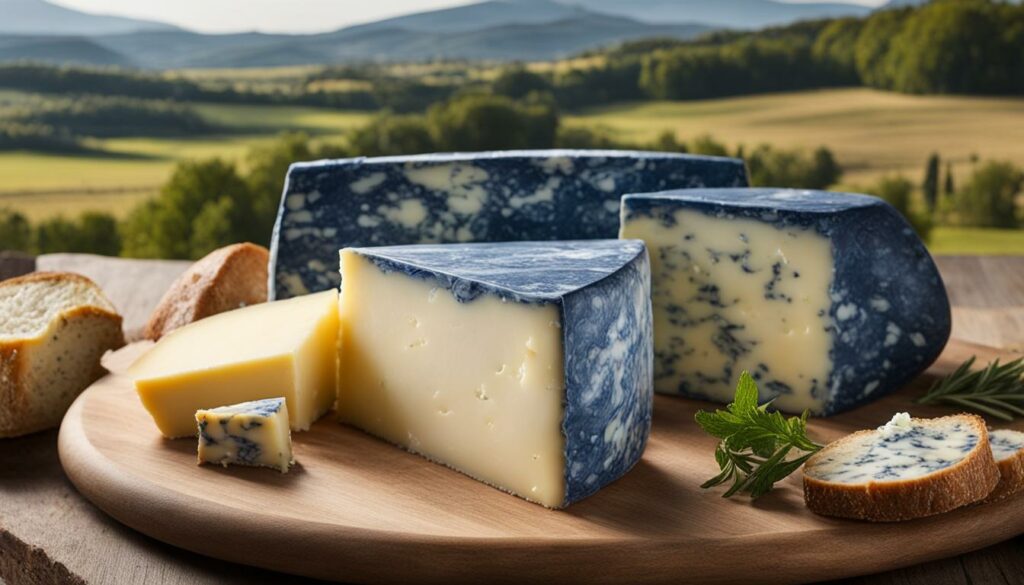
Where to Buy Bleu Des Causses Cheese
If you’re eager to savor the deliciousness of Bleu Des Causses Cheese, you’re in luck! This artisanal French blue cheese can be purchased from a variety of reputable cheese shops and online retailers. Here are some notable options to consider:
| Cheese Shop | Online Retailer |
|---|---|
| Fromages | Mouse Trap Cheese |
| The Courtyard Dairy | DeLaurenti |
These establishments take pride in sourcing high-quality cheeses and providing a diverse selection for their customers. From local cheese shops that offer a curated range of artisanal delicacies to online retailers that deliver convenience and wider options, you’ll find Bleu Des Causses Cheese readily available.
Keep in mind that prices and quantities may vary between different vendors, so it’s always a good idea to explore these options and find the one that best suits your preferences and needs.
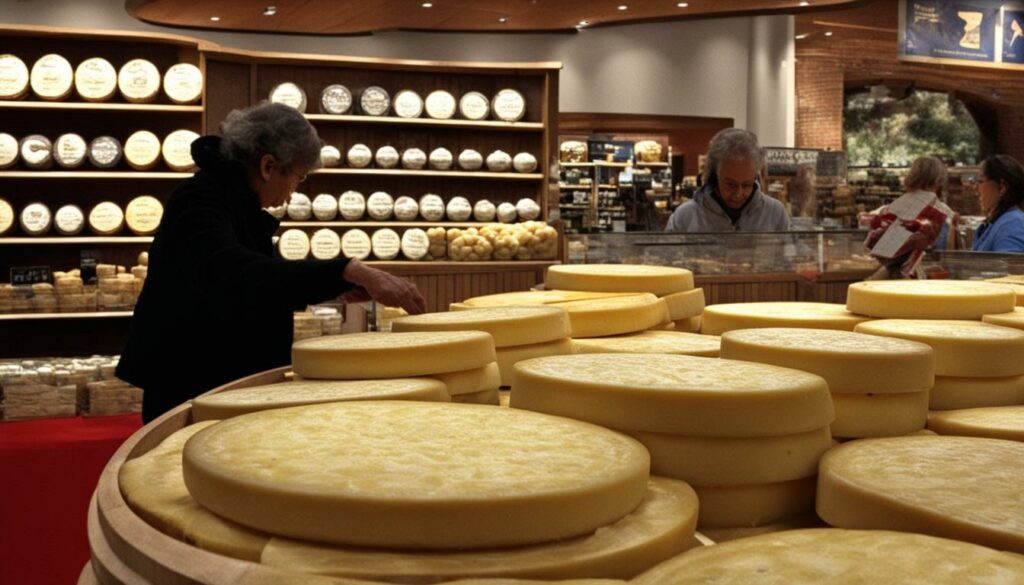
With these trusted sources, you can easily get your hands on this delectable cheese and embark on a culinary adventure with Bleu Des Causses.
Other Lesser-Known French Cheeses to Explore
France is renowned for its diverse selection of cheeses, offering a plethora of flavors, textures, and regional specialties. While Bleu Des Causses is a delightful choice, there are several other lesser-known French cheeses that are definitely worth exploring. From semi-soft varieties to pungent blues, each cheese has its own unique characteristics that make it a delightful addition to any cheese board or culinary masterpiece.
Tomme de Savoie
A classic mountain cheese from the Savoie region, Tomme de Savoie boasts a mild and nutty flavor with a touch of tartness. It features a semi-soft texture and a natural rind, making it a versatile cheese for eating on its own or pairing with your favorite charcuterie.
Banon
Hailing from the Provence-Alpes-Côte d’Azur region, Banon is a small, soft cheese made from goat’s milk. Encased in chestnut leaves, it develops a unique earthy flavor with hints of nuts and mushrooms. This cheese is a true taste of Provence.
Fourme d’Ambert
Originating from the Auvergne region, Fourme d’Ambert is a creamy and mild blue cheese known for its distinct cylindrical shape. Its velvety texture and delicate blue veins result in a cheese that is perfect for spreading on crusty baguettes or incorporating into salads and savory dishes.
Valençay
Valençay is an iconic pyramid-shaped cheese from the Loire Valley. Made from goat’s milk, it has a subtly tangy and citrusy flavor that intensifies with age. The rind is covered with a layer of vegetable ash, adding an earthy and slightly salty note to the cheese.
Comté
Comté is a hard cheese that comes from the eastern regions of France, particularly Franche-Comté. It is crafted from raw cow’s milk and aged for a minimum of four months, resulting in a complex and nutty flavor profile with hints of fruit and caramel. Comté is a versatile cheese that can be enjoyed on its own or melted into gratins and fondues.
Ossau-Iraty
Ossau-Iraty is a traditional Basque cheese made from sheep’s milk. With a smooth and slightly oily texture, it features a rich, buttery flavor with a subtle hint of nuts and fruit. This cheese pairs beautifully with fruity wines and crusty bread.
Mimolette
Mimolette is a golden-colored cheese from the northern region of Lille. It has a firm, yet crumbly texture and a slightly nutty and sweet flavor. The distinct spherical shape and savory taste make Mimolette an eye-catching addition to any cheese platter.
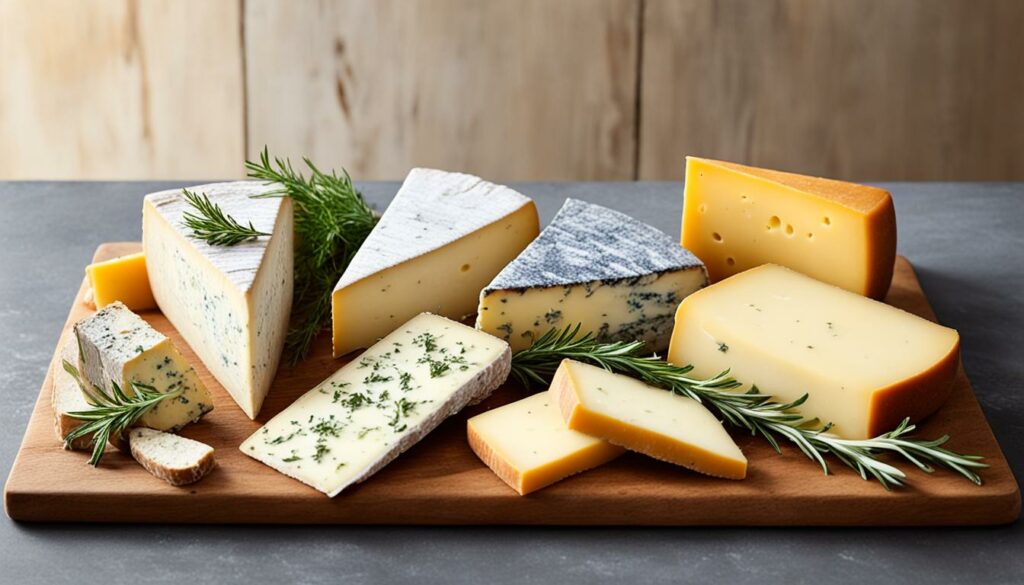
Bleu d’Auvergne
Bleu d’Auvergne is a rich and creamy blue cheese from the Auvergne region in central France. With its distinctive blue veins and tangy flavor, this cheese adds a bold and intense kick to any dish or cheese board.
Rigotte de Condrieu
Rigotte de Condrieu is a small goat’s milk cheese from the Rhône-Alpes region. It has a wrinkled rind and a creamy texture with a delicate and slightly acidic taste. This cheese is perfect for those who enjoy the unique flavors of goat cheese.
Pélardon
Pélardon is a traditional goat’s milk cheese produced in the Cévennes region. Its smooth, creamy texture and slightly nutty flavor make it a favorite among cheese enthusiasts. This cheese is best enjoyed with a glass of dry white wine.
Rocamadour
Rocamadour is a small, semi-soft cheese made from goat’s milk in the Midi-Pyrénées region. It has a creamy and tangy flavor with a subtle goatiness that intensifies as it ages. Rocamadour is a delightful addition to salads or enjoyed on its own with a glass of red wine.
Pyrenean Tomme
Pyrenean Tomme is a versatile cheese with a natural rind and a smooth, semi-soft texture. It is mild and slightly sweet, making it a crowd-pleaser for both cheese aficionados and beginners.
Laguiole
Laguiole is a firm and smooth cow’s milk cheese that originates from the Aubrac region. This cheese has a nutty and fruity flavor, often compared to the renowned Swiss Gruyère. It is a perfect option for melting or grating over your favorite dishes.
Saint-Nectaire
Saint-Nectaire is a semi-soft cheese made from cow’s milk in the Auvergne region. It has a creamy and velvety texture, with a delicate and tangy flavor. This cheese pairs beautifully with red wines and is a staple in French cuisine.
Beaufort
Beaufort is a semi-firm cheese that comes from the French Alps. It boasts a rich and buttery flavor with hints of nuts and fruit. Beaufort is a versatile cheese that can be enjoyed on its own, shredded into gratins, or used as an ingredient in traditional raclette.
Chaource
Chaource is a soft-ripened cheese produced in the Champagne region. With its bloomy rind and creamy texture, this cheese offers a subtle balance of flavors—slightly salty and tangy with a hint of mushrooms. Chaource is perfect for spreading on crackers or enjoying with a glass of bubbly.
Cantal
Cantal is a semi-hard cheese made from cow’s milk in the Auvergne region. It has a firm and crumbly texture with a distinctively tangy and buttery flavor. Cantal is a staple in French cuisine and can be enjoyed in a variety of dishes or on its own.
Persillé de Tignes
Persillé de Tignes is a blue cheese from the Tignes region. It has a crumbly and creamy texture, and its bold and salty flavors are perfectly balanced with a hint of sweetness. This cheese pairs well with robust red wines and is sure to impress any cheese lover.
Maroilles
Maroilles is a soft and pungent cow’s milk cheese from the Nord-Pas-de-Calais region. It has a strong and savory flavor with a rich, creamy texture. Maroilles is a favorite among cheese connoisseurs and adds a bold and distinctive taste to any dish or cheese board.
| Cheese | Origin | Flavor | Texture |
|---|---|---|---|
| Tomme de Savoie | Savoie region | Mild and nutty | Semi-soft |
| Banon | Provence-Alpes-Côte d’Azur region | Earthy with hints of nuts and mushrooms | Soft |
| Fourme d’Ambert | Auvergne region | Creamy with distinct blue veins | Semi-soft |
| Valençay | Loire Valley | Tangy with a touch of citrus | Soft |
| Comté | Eastern France (Franche-Comté) | Nutty with hints of fruit and caramel | Hard |
| Ossau-Iraty | Basque region | Rich and buttery with nutty undertones | Firm |
| Mimolette | Lille region | Subtle nuttiness and slight sweetness | Firm |
| Bleu d’Auvergne | Auvergne region | Intensely bold and tangy | Semi-soft |
| Rigotte de Condrieu | Rhône-Alpes region | Delicate and slightly acidic | Soft |
| Pélardon | Cévennes region | Smooth and creamy with nutty flavors | Soft |
| Rocamadour | Midi-Pyrénées region | Creamy and tangy with a goatiness | Semi-soft |
| Pyrenean Tomme | Pyrenees region | Mild and slightly sweet | Natural rind |
| Laguiole | Aubrac region | Nutty and fruity | Firm |
| Saint-Nectaire | Auvergne region | Creamy and tangy | Semi-soft |
| Beaufort | French Alps | Rich and buttery | Semi-firm |
| Chaource | Champagne region | Slightly salty and tangy with mushrooms | Soft |
| Cantal | Auvergne region | Tangy and buttery | Semi-hard |
| Persillé de Tignes | Tignes region | Bold and salty with a hint of sweetness | Crumbly and creamy |
| Maroilles | Nord-Pas-de-Calais region | Strong and savory | Soft |
Conclusion
Embark on a culinary adventure and discover the wonders of French cheeses, with Bleu Des Causses Cheese leading the way. From its milder flavors to the robustness of Roquefort, French cheeses offer a diverse and delightful range of taste experiences. Whether you consider yourself a cheese connoisseur or simply have a passion for good food, exploring the hidden gems of French cheese is sure to expand your appreciation for the artistry and diversity of this beloved culinary tradition.
Indulge in the creamy, crumbly texture of Bleu Des Causses Cheese and let it transport your taste buds to the Languedoc region of southern France. With its rich, buttery, and slightly spicy taste, this artisanal French blue cheese perfectly captures the essence of the region’s culinary heritage. Packed with history and a reflection of unique terroir, Bleu Des Causses Cheese is a must-try for any culinary enthusiast.
So, whether you’re hosting a wine and cheese party or simply looking to elevate your everyday meals, add a touch of French sophistication to your culinary repertoire. With Bleu Des Causses Cheese and other lesser-known French cheeses, you’ll embark on a flavorful journey that will leave you craving for more. Bon appétit!
FAQ
What is Bleu Des Causses Cheese?
Bleu Des Causses Cheese is a gastronomic treasure from the Languedoc region of southern France. It is an artisanal French blue cheese with a creamy yet crumbly texture and a rich, buttery, slightly spicy taste.
How does Bleu Des Causses compare to Roquefort cheese?
Bleu Des Causses is often considered a milder variant of Roquefort cheese. Both cheeses share a similar production process and are cave-aged, but Bleu Des Causses has its own unique flavor profile.
What are the flavor characteristics of Bleu Des Causses Cheese?
Bleu Des Causses has a rich and buttery flavor with a distinct tanginess from the blue mold veins. It has an earthy undertone and complexity due to the aging process in natural limestone caves. Some consumers also detect notes of mushrooms or grass in the finish.
What are some recommended pairings for Bleu Des Causses Cheese?
Bleu Des Causses pairs well with Cornas, Lirac, and Jurançon wines, as well as omelets, pasta, and potatoes. It can be enjoyed on its own or paired with other complementary flavors.
What is the history of Bleu Des Causses Cheese?
Bleu Des Causses Cheese originated in the Aveyron region of France in 1926. It is made from full-fat cow’s milk and is matured in cheese cellars carved into the rock. The cheese is protected by the AOC recognition and shares its production methods with Roquefort cheese.
Where can I buy Bleu Des Causses Cheese?
Bleu Des Causses Cheese can be purchased from various cheese shops and online retailers, including Fromages, The Courtyard Dairy, DeLaurenti, and Mouse Trap Cheese. Prices and quantities may vary, so it’s best to explore these options and find the one that suits your preferences and needs.
What are some other lesser-known French cheeses to explore?
In addition to Bleu Des Causses, there are a variety of lesser-known French cheeses worth exploring, such as Tomme de Savoie, Banon, Fourme d’Ambert, Valençay, Comté, Ossau-Iraty, Mimolette, Bleu d’Auvergne, Rigotte de Condrieu, Pélardon, Rocamadour, Pyrenean Tomme, Laguiole, Saint-Nectaire, Beaufort, Chaource, Cantal, Persillé de Tignes, and Maroilles. Each cheese offers its own unique flavors, textures, and regional origins.
How would you describe the culinary adventure of exploring French cheeses?
Exploring French cheeses, including Bleu Des Causses Cheese, can be a delightful culinary adventure. From the milder flavors of Bleu Des Causses to the robustness of Roquefort, French cheeses offer a wide range of taste experiences. Whether you’re a cheese connoisseur or simply a lover of good food, discover the hidden gems of French cheese and expand your appreciation for the artistry and diversity of this beloved culinary tradition. Bon appétit!

